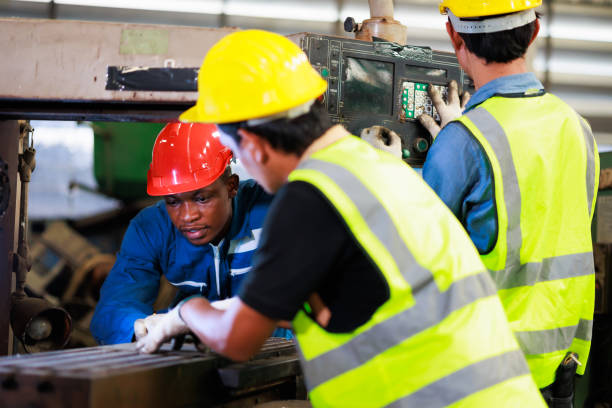Maintaining a safe work environment requires a lot of investment. Companies and employers should take responsibility for workplace safety and provide employees with the proper personal protective equipment and training. Ultimately, these are the foundations that can keep employees safe at work.
Of course, different manufacturing companies require different kinds of proper safety equipment. And the protection employees need to perform different tasks is also different. But there are still some safety equipment that are universally needed in the manufacturing industry. Here are some basic types of personal protection.
 1. Head Protection
1. Head Protection
The head is always the primary consideration when preparing safety equipment. Every employee in manufacturing is likely to need head protection. OSHA regulations require that any employee who is likely to be struck by an object above them needs to wear a hard hat. Even if there is no risk of an object falling from a height in the work environment, workers can wear safety helmets to prevent accidental head impacts.
2. Hand Protection
Hands are one of the most important body parts for manufacturing workers, as all work needs to be done by hands. Therefore providing hand protection for employees should be a priority. Any employee working with chemicals, metalworking or electricity should wear safety gloves. This is also true for workers who work in extreme temperature environments. Safety gloves come in many different types and are often designed for specific tasks. Careful consideration should be given when choosing.
3. Eye and Face Protection
Eye and face injuries are common hazards in the workplace and often result in serious injuries. However, most eye and face injuries can be prevented through the proper use of personal protective equipment. Safety goggles or face shields can prevent debris or flying particles from hitting a person directly in the eye. Employees working in the heat should also have the proper equipment to protect their face and eyes.
4. Ear Protection
Ear protection may be easy to forget when discussing safety equipment in manufacturing, but it is by no means unimportant. Noisy work environments can be harmful to workers' hearing, and in the long run can even lead to health disorders and permanent damage. Ear muffs or ear plugs are the most commonly used hearing protection equipment. Using this equipment not only protects workers' hearing, but also helps them focus on their work in a noisy environment.
5. Protective Clothing
Last but not least, the right workwear can be considered as one of the safety equipment that workers need. For example, in the workshops or warehouses of some large manufacturing companies, there may be vehicles driving back and forth. This is where workers should wear a high-visibility safety vest or jacket to warn drivers of their location. Manufacturers in some industries may also need to have fire or chemical resistant coveralls for their employees.
Before you try to change the PPE habits of your employees, understand what those habits are. Therefore, now is the time to observe and collect data.
You're already familiar with this type of data collection, and you do it all the time when assessing safety hazards. Only this time, you're observing employee behavior.
It's important to remember that resistance to PPE adoption is often more complex than simple laziness. Employees don't want to get hurt either, and there are many reasons why they may ignore or refuse to wear PPE.
That's why it's important to observe their PPE habits. If you can identify patterns in PPE habits, you can understand where these habits come from and how to address them.
In some cases, employees may not understand why they need PPE or even know how to use it properly. That's why training is one of the most important tools you can use to promote safety equipment.
The good news is that if you've done a good job of observing PPE habits, you'll know what type of training is needed. For example, if you observe that employees have been using PPE incorrectly, it's prudent to reacquaint them with how to use it properly. or, if you're introducing new PPE, train them on how to use the new equipment.
Even if your employees are familiar with their PPE, it is still worthwhile to train them occasionally on how and why to use it. Employees should not view PPE as punitive or as a nuisance that hinders their productivity. It is a protective tool, and they need to use it as such.
Copyright © Hebei Sinotools Industrial Co.,Ltd. All Rights Reserved | Powered by  Sitemap
Sitemap